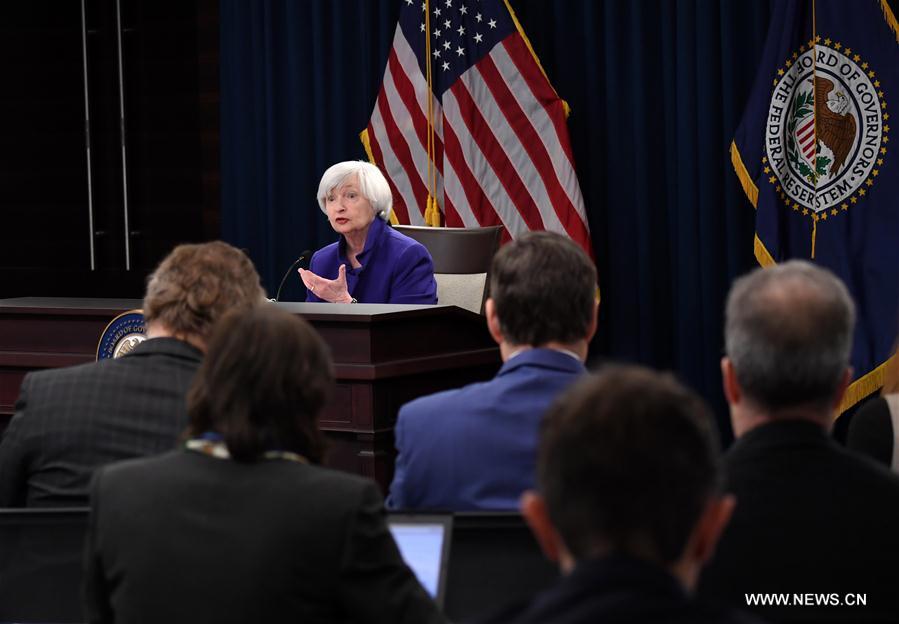
U.S. Federal Reserve Chair Janet Yellen speaks during a news conference in Washington D.C., the United States, on Dec. 13, 2017. The U.S. Federal Reserve on Wednesday raised the benchmark interest rate by 25 basis points, the third such increase in 2017. (Xinhua/Yin Bogu)
by Xinhua writers Wang Wen, Sun Oumeng
NEW YORK, Dec. 13 (Xinhua) -- The U.S. central bank's announcement on Wednesday to raise the benchmark interest rate by 25 basis points had little impact on the financial markets as it was widely expected, said analysts.
The S&P 500 ended the day little changed, and the Dow Jones Industrial Average pared its gains while still managing to close at record high on Wednesday. Treasury bonds extended gains and the dollar fell after the Federal Reserve offered few surprises at its December policy meeting.
"We expect that today's quarter-point rate hike will have a negligible effect on the stock markets and the dollar given that the market fully anticipated it, with Fed fund futures registering a 100 percent chance of today's increase," said Humberto Garcia, head of Global Asset Allocation for Bank Leumi USA.
He added that the Fed's slow-and-steady approach gives most corporations time to adapt to gradually increasing debt service and to position themselves to avert the kinds of liquidity crunches that can arise under a regime of rapid and steeper interest rate hikes.
"Given the broad and relatively strong economic backdrop, we expect that the associated increase in the Prime Rate and other benchmark interest rates that underpin floating rate debt to have a small effect on the risk of corporate debtors," said Garcia.
Apart from the widely anticipated interest hike, the markets were more focused on the timing and size of future adjustments to the target range.
Fed officials said they will assess realized and expected economic conditions relative to its objectives of maximum employment and 2 percent inflation. For the moment, they still envisioned three more rate hikes in 2018, unchanged from their forecast in September.
Market analysts and financial institutions had similar projections on the pace of interest rate hikes.
Both Bank of America Merrill Lynch and Morgan Stanley have forecasted three more hikes in 2018 and two more hikes in 2019 in their latest reports.
However, analysts did have concerns about Fed keeping labor conditions and inflation targets as major indicators to instruct the pace of interest rate hikes.
"(We) do expect some further investigation into the applicability of these two measures and corresponding targets as the principal inputs to Fed rate policy and decision making," said Garcia.
Analysts also noted the change of the Fed's "big three" and saw little possibility of a shift in the monetary policy.
Omair Sharif, senior U.S. economist at Societe Generale, said incoming Fed Chair Jerome Powell may be more hawkish than his predecessor Janet Yellen, but the central bank will not speed up rate hikes after he takes office.
"While FOMC (The Federal Open Market Committee) dynamics can and do fluctuate, the resounding market appreciation for the slow-and-steady approach suggests that the FOMC should maintain that profile in its decision making and communications during the coming Powell era," said Garcia.
As for the outlook of the stock market, Yellen said in her final press briefing that current high stock market valuations do not mean the market is overvalued or that a sell-off would pose much risk to the economy or financial system.
"We are enjoying solid economic growth with low inflation. And the risks to the global economy look more balanced than they have in many years," she said, adding that low-rate environment is supportive of higher value.
Market analysts differed in their views of key risks for U.S. equities in 2018.
Bank of America Merrill Lynch considered inflation the top risk.
"Our proprietary indicators suggest that inflationary pressures are building, which could not only hasten the Federal Reserve's tightening but, in a world of scarce pricing power, could pressure corporate margins," the institution said in a report.
It estimated that S&P 500 target at 2018 year-end is 2,800, a 9-percent increase over current levels. By the end of 2025, the S&P 500 will reach 3,500.
Others are more concerned about external factors.
"We see the main risks to economic growth in the coming year to center on exogenous shocks, perhaps instigated by geopolitical events," said Garcia.















